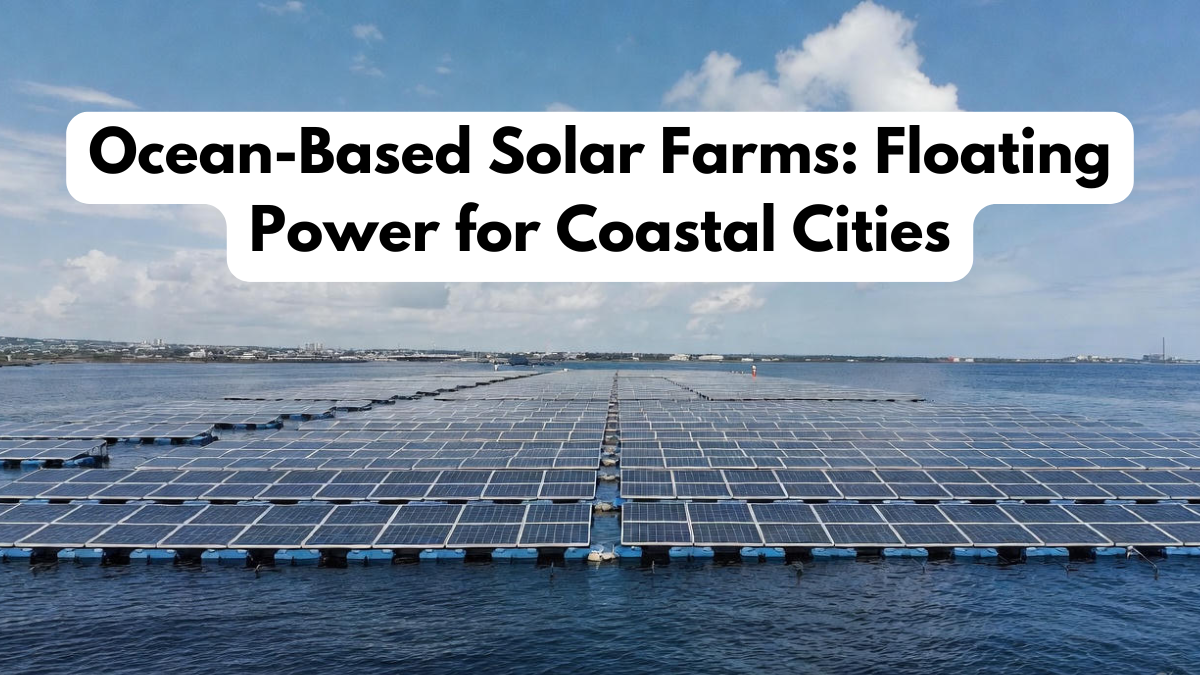The rise of ocean solar farms is ushering in a new era of clean, abundant, and sustainable energy generation. As global demand for renewable electricity grows, coastal nations are turning to the vast surface of the sea as an ideal location for solar harvesting. By using floating platforms, these projects maximize sunlight exposure and reduce the need for land-based installations. Supported by advancements in renewable ocean energy, floating solar systems offer a powerful solution for countries struggling with limited land availability and rising energy costs. As climate pressures increase, ocean solar farms are quickly becoming one of the world’s most promising clean-tech innovations.

How Ocean Solar Farms Are Changing Renewable Power Production
Traditional land-based solar installations face challenges such as land shortages, expensive real estate, and environmental disruptions. Ocean solar farms, however, take advantage of the ocean’s open space, allowing countries to generate substantial amounts of electricity without sacrificing agricultural or urban land. With the support of renewable ocean energy, these floating systems harness sunlight efficiently while benefiting from natural water cooling, which boosts energy output.
Floating platforms are anchored securely to withstand waves, tides, and strong winds. These systems also adapt to rising sea levels, making them an excellent long-term investment for coastal regions. Thanks to smart engineering and AI-powered tracking systems, ocean solar farms can adjust panel orientations to maximize sunlight exposure every hour of the day.
Technology Behind Ocean-Based Solar Farms
The success of ocean solar farms depends on advanced materials, marine engineering techniques, and innovative energy conversion systems. These floating structures incorporate buoyant frames, corrosion-resistant materials, and intelligent monitoring systems that ensure long-term performance. The integration of renewable ocean energy technologies further enhances their output and efficiency.
Below is a table highlighting the major components that make ocean solar farms work:
| Component | Function | Benefit |
|---|---|---|
| Floating Platforms | Keep solar panels above water | Ensures stability and durability |
| Marine-Grade Solar Panels | Resist corrosion and moisture | Enhances long-term performance |
| Anchoring Systems | Secure structures to seabed | Prevents drifting during storms |
| Cooling Systems | Utilize seawater’s natural cooling | Boosts energy efficiency |
| Renewable Ocean Energy Tech | Complements solar generation | Provides hybrid clean power |
Together, these components enable ocean solar farms to deliver reliable energy even in challenging marine environments. With continuous research, experts are blending solar with tidal and wave energy, creating hybrid systems that maximize renewable ocean energy potential.
Benefits of Ocean Solar Farms for Coastal Cities
Coastal cities worldwide are adopting ocean solar farms as part of their long-term sustainability strategies. The integration of renewable ocean energy supports cleaner air, reduced emissions, and lower dependence on fossil fuels.
Key benefits include:
- Large-scale renewable power generation
- Lower land usage compared to traditional solar fields
- Increased panel efficiency due to water cooling
- Reduced heat island effects
- Support for climate resilience
- Hybrid opportunities with renewable ocean energy systems
- Reliable performance during high electricity demand periods
These advantages demonstrate why many countries in Asia, Europe, and the Middle East have launched pilot floating solar programs. Over time, mass adoption of ocean solar farms may significantly reduce global carbon emissions.
Future Potential of Floating Solar Technology
The future of ocean solar farms is extremely promising. Scientists are exploring new floating materials, stronger anchoring methods, and advanced solar coatings that improve energy capture. Integrating AI monitoring systems can help predict weather patterns, optimize panel angles, and detect maintenance needs early. With expanding renewable ocean energy capabilities, floating solar installations may soon link with underwater turbines or wave-energy converters to form large hybrid power parks.
Many countries are planning gigawatt-scale floating farms that could power entire cities. As the cost of marine-friendly solar panels decreases, adoption will accelerate. Future innovations may even include solar carpets laid over calm waters or modular systems that expand automatically as energy needs grow. Ultimately, ocean solar farms could become a central pillar of global renewable power generation.
Conclusion
The emergence of ocean solar farms marks a groundbreaking shift in how the world produces clean electricity. Supported by powerful renewable ocean energy innovations, these floating solar fields offer a sustainable, efficient, and scalable solution to global energy challenges. By utilizing ocean surfaces, they minimize land consumption while maximizing output. As technology advances, ocean solar farms will play a major role in powering future coastal cities, reducing emissions, and accelerating the world’s transition to clean energy.
FAQs
What are ocean solar farms?
Ocean solar farms are floating platforms equipped with marine-grade solar panels that generate electricity using sunlight over water, supported by renewable ocean energy systems.
Are ocean solar farms safe during storms?
Yes, they use strong anchoring systems and durable materials designed to withstand waves, winds, and harsh marine conditions.
How efficient are ocean solar farms compared to land solar farms?
Ocean solar farms are often more efficient due to natural seawater cooling, which boosts panel performance.
Can ocean solar farms support coastal cities?
Absolutely. They can generate large-scale Clean energy and complement renewable ocean energy sources.
Do floating solar farms harm marine ecosystems?
When designed properly, ocean solar farms have minimal environmental impact and may even create shade zones that support marine life.
Click here to learn more